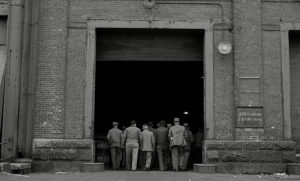A FEW years ago I dragged the family to see a rare cinema screening in Perth of my favourite film.
Suffice to say, in this day and age, they don’t share my enduring enthusiasm for On The Waterfront.
The 1954 winner of the Best Film Oscar is a triumph of technical skill, acting and story-telling.
At the time of its release, Hollywood was still struggling with the aftermath of activities by the House Committee on Un-American Activities conducted a couple of years earlier.
The Committee had spread anti-communist sentiment as a result of Hearings that turned professionals against each other, including film-makers, and resulted in some directors and writers being blacklisted.
Turkish-Born director Elia Kazan was one of those caught up in the maelstrom and was criticised for his testimony.
Rather than try to put the experience behind him, Kazan tackled the philosophical and emotional toll head-first with On The Waterfront.
The film is set on the tough docks of New York during the Depression years. Trade is controlled by organised crime elements who decides what comes in and out and how much has to be paid for trouble-free operations.
The Mob also decides who can work and who can’t, barring men with struggling families who refuse to use part of their wage to take out loans at exorbitant interest rates.
Proud men are forced to debase themselves, and fight each other for small scraps of opportunity to work for the Mob.
On this Waterfront the king is Johnny Friendly, a ruthless bear of a man played with incredible menace and authority by Lee J. Cobb.
One of Johnny’s closest lieutenants is his banker, Charley Molloy, an intelligent and quiet man who has carved a place of influence in order to survive. He is played with deep conviction and under-statement by the great Rod Steiger.
Charley’s younger brother is the shy and simple Terry who once had a promising career as a professional boxer but now acts as a standover man for Johnny’s organisation.
A longshoreman named Eddie Doyle has decided to give evidence to a State Commission investigating corruption on the Waterfront.
Terry is ordered to entice Eddie onto the roof of his building but doesn’t know he will be pushed to his death.
The death sparks a renewed sense of outrage amongst the exploited workers, bringing Terry into contact with the dead man’s sister, Edie, played beautifully by Eva Marie Saint, and a priest, Father Barr, one of the best supporting performances ever by a commanding Karl Malden.
Of course I have left the best until last.
Marlon Brando is magnificent as Terry. The famous scenes between Brando and Steiger in the rear seat of a moving car and Brando’s seduction of Saint are superlative (watch how he improvised in picking up and playing with her glove), but every scene is a gem.
Any still from Kazan’s film looks like it could have been an actual monochrome photograph from the place, time and people in portrays.
It would be a crime against art to subject Boris Kaufman’s beautiful black and white cinematography to colourisation while Leonard Bernstein’s music score perfectly enhances the film’s dramatic narrative.
There isn’t a word wasted in Budd Schulberg’s script that seems to both take its time examining the moral dilemma confronting Terry while charging to the inevitable violent confrontation between Terry and Johnny, workers and Mob, freedom and control, life and death.
On the Waterfront is quite simply one of the best films ever made. I love it.
